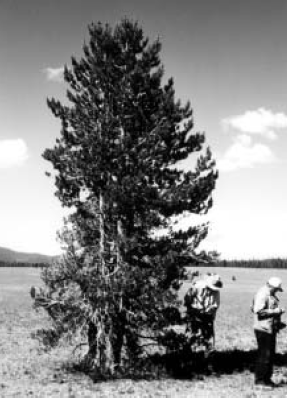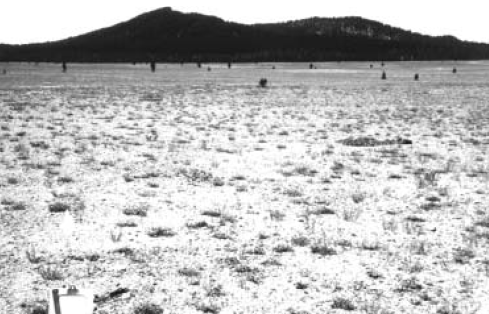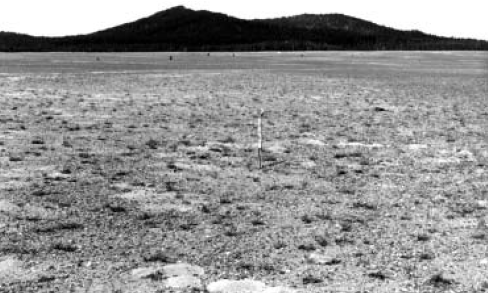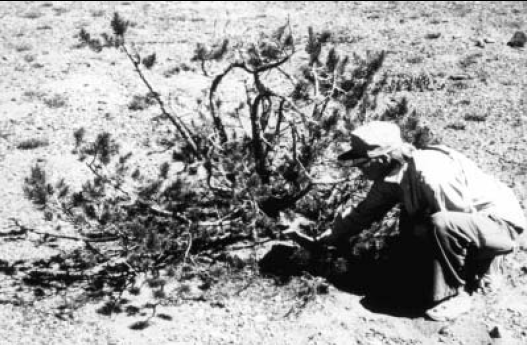Park and researcher contributions
Figure 2. Typical multi-stemmed lodgepole pine photographed in the summer of 2000. This tree has nine trunks and measured 19 feet in height.
The project was very much a joint effort from its 1965 beginning. Crater Lake managers and staff provided time and transportation for doing the research. Purdue University provided the climate and recording equipment. However, the single most important ingredient was the participation of park staff. Park biologist Richard Brown was the enthusiastic instigator. Staff donated their time off to help tabulate plants on the plots and make climate and soil recordings. The park had a darkroom, and several staff developed photos of the plots. The maintenance staff made the iron rods to mark the plots and devised a coding system for their identification. It became everyone’s project and provided a focus for the developing camaraderie among the staff.
The case for long-range vegetation studies
Park settings are ideal places for long-range vegetation studies. The 1965 study provided a snapshot in time. It told what was on the Pumice Desert during that particular summer. But it was a static picture. Long-range monitoring has the following advantages:
1. Once a study is set up, it can be monitored with little additional effort or cost. Each additional visit to the site involved about five days each for me and a few colleagues.
2. Photo points can speak volumes even if vegetation is not tabulated. Photo points, once established, are usually not difficult to find again.
3. Park areas are generally not disturbed by human-made intrusions. The vegetation and the landscape are for the most part protected from unnecessary human-caused impacts. However, in this study, there were two artificial intrusions on the Pumice Desert. The first was the route of the Pacific Crest National Scenic Trail. Records show the trail was probably routed on an old fire road through the Pumice Desert in 1929. The trail was moved to a route east of the Pumice Desert in 1976 to line up with the trail around Mt. Thielson north of the park and to reduce plant damage in the Pumice Desert. However, the track and the vegetation changes can still be seen along the old route. The second intrusion is the trampling that has occurred near the interpretive sign. Although the changes near the interpretive sign were not part of the study, both examples are valuable because they illustrate the impact that can occur on delicate plant communities.
4. The data from the 1965 tree plot showed that few trees had populated the Pumice Desert. The 1977 and 1995 vegetation plot data showed little change in the average plant cover or individuals per square foot. Expectations would be that there was also little change in the tree plot data. However, the 2000 data on the tree plot showed that succession was indeed proceeding. Had we not set up and followed up on an additional plot to only monitor tree numbers, we would have assumed that little had changed on the Pumice Desert. We had two sets of data (tree plot and vegetation plot), and if we had stopped with only one set, we would not have had a complete picture. Why the tree numbers have increased while the vegetative numbers remained fairly constant is another interesting question. The answer may be as simple as normal population dynamics, which would be more apparent in the shorter-lived herbaceous plants. Spring moisture, for example, would have a definite influence on the survival of seedling herbaceous plants with shallow root systems. Patience and thoroughness are necessities for long-range monitoring.
Figure 4. View from northwest corner of the tree plot, lower photo taken in 1965; upper photo taken in 2000. Note the increased number of trees in the middle ground in the 2000 photo. Note the large areas of barren ground. Pocket gopher mounds show in the foreground of the 1965 photo.
Summary
Research during the past 35 years has shown that many interacting factors undoubtedly combine to slow plant succession on the Pumice Desert, including climate, short growing seasons, sterile soils, hot soil temperature in summer affecting seedling survival, and rodent or gopher activity that aerated and mixed the soils (a positive thing) but also negatively affected the vegetation when they ate the roots. However, the number of trees that have become established on the 100-acre tree plot has increased by 75% between 1965 and 2000. Eventually, as succession proceeds, conditions will become more hospitable for new seedlings. The plots established in 1965 allow continued monitoring of this progress. The surrounding lodgepole pine will eventually infiltrate the area and the Pumice Desert will cease to exist.
I greatly appreciate the assistance of the staff of Crater Lake National Park in the many stages of this research. I also would like to acknowledge the assistance of plant ecologists Fred Hall and William Hopkins in resurveying the vegetation plots and the cheerful assistance of Kirk M. Horn throughout.
References
Applegate, E. 1939. Plants of Crater Lake National Park. American Midland Naturalist 22(2): 225–314.
Horn, E. M. 1968. Ecology of the Pumice Desert. Northwest Science 42(4):141–149.
Sternes, G. L. 1963. Climate of Crater Lake National Park. Crater Lake Natural History Association, Crater Lake, Oregon.
Williams, H. 1942. The Geology of Crater Lake National Park, Oregon. Carnegie Institution of Washington Publication 540,Washington, D.C.
About the author
Elizabeth L. Horn holds a B.A. from Valparaiso University and an M.S. from Purdue University and began this research as a seasonal ranger-naturalist at Crater Lake National Park from 1964–1965. She retired from a 30-year career with the U.S. Forest Service and now resides in West Yellowstone, Montana, and can be reached at khcritters@aol.com.
Figure 3. Author examines base of multi-stemmed, bushy lodgepole pine. Multiple trunks are not uncommon in harsh environments. There could be several causes. Genetics can create a predisposition for multiple stems, but the surrounding forest did not exhibit multiple stems. Rodent seed caches could result in multiple stems. However, examination of seedlings under 6 inches in height determined that seedlings have single stems, while slightly larger bushy-shaped trees clearly showed apical stem damage. This would release the side stems to grow upright. The damage could be caused by wind-borne pumice abrasion, gophers, or winter drying from low snow levels. In some cases, gopher gnawings were clearly present. Although the researchers have some guesses, the cause of this phenomenon would be an interesting future study.





